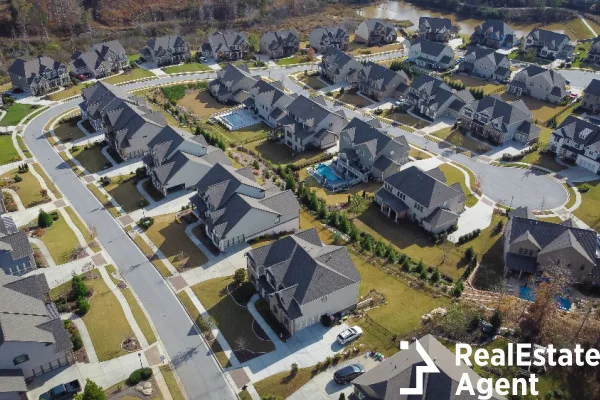 Have you ever stopped to think about who's behind the scenes, making sure our neighborhood stays awesome? That's where homeowners’ associations (HOAs) come in - the real MVPs you might not even notice! These non-profit entities are like the glue holding our community together, taking care of everything from fixing up the park to organizing block parties. With roots dating back to the mid-twentieth century, HOAs have grown into the heartbeat of our neighborhood vibe. They're not just about rules and regulations but making sure our streets feel like home, sweet home! Below is an in-depth exploration of the origins and transformation of homeowners’ associations into the powerful institutions they are today. We will take a closer look at how do homeowners associations work, and answer the question of what is the purpose of an HOA.
Have you ever stopped to think about who's behind the scenes, making sure our neighborhood stays awesome? That's where homeowners’ associations (HOAs) come in - the real MVPs you might not even notice! These non-profit entities are like the glue holding our community together, taking care of everything from fixing up the park to organizing block parties. With roots dating back to the mid-twentieth century, HOAs have grown into the heartbeat of our neighborhood vibe. They're not just about rules and regulations but making sure our streets feel like home, sweet home! Below is an in-depth exploration of the origins and transformation of homeowners’ associations into the powerful institutions they are today. We will take a closer look at how do homeowners associations work, and answer the question of what is the purpose of an HOA.
HOAs - A journey through time
In the late 1940s, American veterans returning from World War II struggled to find affordable housing. Bill Levitt, himself a veteran, noticed this problem and, along with his father Abraham and brother Alfred, decided to do something about it. They invested in over 4,000 acres of land on Long Island, New York, and used innovative construction methods to build affordable homes for veterans. This led to the creation of Levittown in 1947.
Although there wasn’t a formal homeowners association (HOA) with official governing documents, the community still had rules and regulations in place. These early rules set the stage for the HOAs we’re familiar with today. As time passed, the Levitt family built similar communities across the country, serving as a blueprint for planned communities and shaping how we live in neighborhoods today.
Later developments
The construction and management of Levittown sparked interest in planned communities, especially with the Federal Highway Act of 1956 making suburban areas more accessible. This led to exclusive suburban developments, supported by the National Association of Housing Cooperatives (NAHC), founded in 1960, which guided cooperative housing communities.
Legal milestones like the Shelley v. Kraemer case in 1948 and the Fair Housing Act of 1968 promoted anti-discriminatory policies, encouraging the growth of planned communities. The Federal Housing Administration (FHA) further fueled this by approving mortgage insurance for condominiums and homes with homeowners’ associations (HOAs) in 1963, facilitating the transition from suburban living to common-interest housing.
However, converting apartments into condos raised concerns about displacing residents, leading to controversies. In response, a group of real estate experts and future Community Associations Institute (CAI) members worked on a plan to balance developer interests with consumer protections. Their efforts contributed to passing the Uniform Relocation Assistance and Real Property Acquisition Act in 1972, establishing standards for federal programs involving real estate acquisition and displacement.
Why do we need HOAs?
 Have you ever wondered why does HOA exists? Homeowner Associations are designed to improve neighborhoods by maintaining shared amenities, setting guidelines, and ensuring a certain level of uniformity among properties. This helps safeguard the collective interests of homeowners. Living in an HOA community has perks, such as avoiding individual maintenance tasks and enjoying communal facilities like gyms or pools. However, opinions vary; some may find the fees burdensome or the rules too restrictive. Despite the mixed opinions, a well-run HOA can enhance property values by maintaining a clean and visually appealing environment. Funds for maintaining common areas and amenities are typically collected through dues and assessments, with reserves set aside for future needs. The approach to funding and managing HOAs can vary across the US, but ultimately, their goal is to improve the overall quality of life within the community.
Have you ever wondered why does HOA exists? Homeowner Associations are designed to improve neighborhoods by maintaining shared amenities, setting guidelines, and ensuring a certain level of uniformity among properties. This helps safeguard the collective interests of homeowners. Living in an HOA community has perks, such as avoiding individual maintenance tasks and enjoying communal facilities like gyms or pools. However, opinions vary; some may find the fees burdensome or the rules too restrictive. Despite the mixed opinions, a well-run HOA can enhance property values by maintaining a clean and visually appealing environment. Funds for maintaining common areas and amenities are typically collected through dues and assessments, with reserves set aside for future needs. The approach to funding and managing HOAs can vary across the US, but ultimately, their goal is to improve the overall quality of life within the community.
How do homeowners associations work?
To answer the question of how do homeowners associations work, first, we need to understand what an HOA is. HOAs are groups formed within residential communities like single-family homes or multi-unit buildings such as townhouses or condos. These associations are set up to establish and enforce rules governing the properties within their jurisdiction. Essentially, HOAs are managed and operated by the community's residents, and becoming a member is a requirement when buying a home within such a community. A landowner can create an HOA, but several considerations and steps are involved in the process.
Each HOA usually elects a board of directors or governors to oversee and enforce its rules and regulations. These rules are often outlined in a document called the Declaration of Covenants, Conditions, and Restrictions (CC&RS), which details various conditions regarding property maintenance and aesthetics. For instance, they might specify rules about the type of fences allowed or the colors homeowners can paint their houses. Violating these guidelines can result in penalties like fines or even legal action.
HOAs also collect fees from homeowners, which vary based on factors such as the type of property, the number of properties in the community, location, amenities offered, and operating expenses. These fees typically range from $200 to $400 per month but can vary widely, especially in luxury neighborhoods. A portion of these fees often goes into a reserve fund for major projects or emergencies, while special assessments may be imposed for unexpected repairs.
The HOA’s board manages the association's finances, including collecting dues, overseeing expenditures, and imposing fines on rule-breakers. They may even place a lien on a property if a homeowner falls significantly behind on their dues or even can take your house. Overall, HOAs play a crucial role in maintaining the quality standards of the community they serve.
Benefits of joining an HOA
 Most folks are familiar with homeowners’ associations mainly for their rules and dues. While these are indeed part of the package, the regulations are in place to enhance the community’s appeal and ensure it’s a fantastic place to call home. An HOA offers numerous perks, making it a highly desirable residential choice. Here are six key benefits to enjoy.
Most folks are familiar with homeowners’ associations mainly for their rules and dues. While these are indeed part of the package, the regulations are in place to enhance the community’s appeal and ensure it’s a fantastic place to call home. An HOA offers numerous perks, making it a highly desirable residential choice. Here are six key benefits to enjoy.
1. Consistent property values
When you join an HOA, you get the perk of keeping property values steady, which is a big deal for many homeowners. The HOA board does the heavy lifting here by making sure everyone follows the rules about keeping their properties spick and span, from lawns to homes and personal stuff.
This isn’t just about individual homeowners; it’s about boosting the whole neighborhood’s value and appeal. So, when you mow your lawn or touch up your paint, you’re not just sprucing up your own place; you’re helping out your neighbors, too.
Plus, the folks on the HOA board? They’re your neighbors, too, and they’re just as invested in keeping things looking good as you are. They’re not some distant authority figures; they’re in the same boat, wanting the community to thrive.
2. Plenty of activities
 Living in a neighborhood with an HOA means there’s always something exciting going on. There's a lot to be part of, from fun barbecues to important meetings and community projects. It’s an excellent way for neighbors to unite, make friends, and improve their community. Whether organizing clean-up events or planning parties, the HOA helps everyone work together to make the neighborhood awesome. So, whether you’re flipping burgers or sharing ideas, every little bit helps make your HOA neighborhood a great place to live.
Living in a neighborhood with an HOA means there’s always something exciting going on. There's a lot to be part of, from fun barbecues to important meetings and community projects. It’s an excellent way for neighbors to unite, make friends, and improve their community. Whether organizing clean-up events or planning parties, the HOA helps everyone work together to make the neighborhood awesome. So, whether you’re flipping burgers or sharing ideas, every little bit helps make your HOA neighborhood a great place to live.
3. Community sense
Living in a community with an HOA offers a profound sense of togetherness. It’s not just about sharing a physical space; it’s about sharing experiences, support, and a sense of belonging with your neighbors and association team. This feeling is invaluable, particularly for individuals who may not have family nearby, as neighbors often step in to fill the void and become like family themselves. Moreover, residing within a community with HOA often means sharing similar lifestyles, interests, and values, which naturally fosters a deeper bond and friendship among residents. Whether lending a helping hand, organizing community events, or simply sharing a friendly chat, the connections forged within such communities enrich lives in countless ways.
4. Variety of amenities
 Communities come with diverse amenities designed to cater to different preferences and needs. Whether you enjoy strolling along scenic walking paths, taking a dip in refreshing pools, working out at state-of-the-art gyms, or unwinding in lush parks, there’s something for everyone. These offerings make these communities ideal for families seeking outdoor fun, seniors looking for leisurely activities, and young adults craving an active lifestyle. So, rest assured, you’ll discover a community ideally suited to your lifestyle and preferences.
Communities come with diverse amenities designed to cater to different preferences and needs. Whether you enjoy strolling along scenic walking paths, taking a dip in refreshing pools, working out at state-of-the-art gyms, or unwinding in lush parks, there’s something for everyone. These offerings make these communities ideal for families seeking outdoor fun, seniors looking for leisurely activities, and young adults craving an active lifestyle. So, rest assured, you’ll discover a community ideally suited to your lifestyle and preferences.
5. Standards of compliance
Homeowners must follow specific rules set by their homeowners association (HOA). Before buying a home, knowing these rules is wise to avoid problems later.
The rules usually cover how you behave and take care of your property. For example, you can't have noisy parties late at night and must follow specific design rules if changing your home. Also, HOAs can instill pet rules. For instance, some HOAs only allow up to two dogs per household. For pet lovers, it’s advisable to check the pet policy of the HOA before moving to such a community.
If neighbors have a problem, the HOA has a group called the board to help fix it. They can also give penalties if someone breaks the rules. Their job is to keep things fair and peaceful for everyone in the community.
6. Common area maintenance
 Living in a well-maintained community offers more than just aesthetic appeal; it enhances the overall quality of life. Picture strolling down streets lined with neatly trimmed trees and vibrant flowers in full bloom, with no speck of litter in sight. This harmonious environment fosters a sense of peace and tranquility, making it easier for residents to unwind and enjoy their surroundings.
Living in a well-maintained community offers more than just aesthetic appeal; it enhances the overall quality of life. Picture strolling down streets lined with neatly trimmed trees and vibrant flowers in full bloom, with no speck of litter in sight. This harmonious environment fosters a sense of peace and tranquility, making it easier for residents to unwind and enjoy their surroundings.
Moreover, the upkeep of such features isn't just about appearances; it directly impacts the community's well-being. Knowing that essential services like tree trimming and waste management are diligently taken care of alleviates the burden of homeownership. It instills confidence and pride in residents, knowing that their neighborhood is being looked after and that they are part of a community that values its collective welfare.
Author’s conclusion
By now, we hope you have a better understanding of how do homeowners associations work and what is the purpose of an HOA. It's clear that homeowners’ associations (HOAs) have indeed grown into something special since their humble beginnings post-World War II. Nowadays, they're like the heartbeat of our neighborhoods, keeping our homes valuable, our weekends lively with events, and our connections with neighbors strong. Sure, there might be some disagreements now and then. Still, HOAs bring us perks like consistent rules, fun community activities, a sense of belonging, excellent amenities, rule-following nudges, and guaranteeing that our shared spaces stay pristine. When we all pitch in, it's incredible how much we can accomplish together, showing that by bonding as neighbors, we can create a place we're all proud to call home.
















Have a question or comment?
We're here to help.